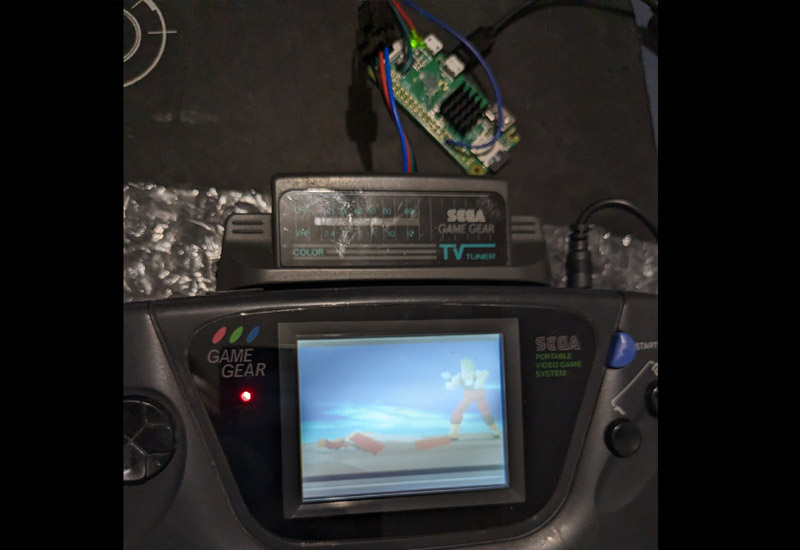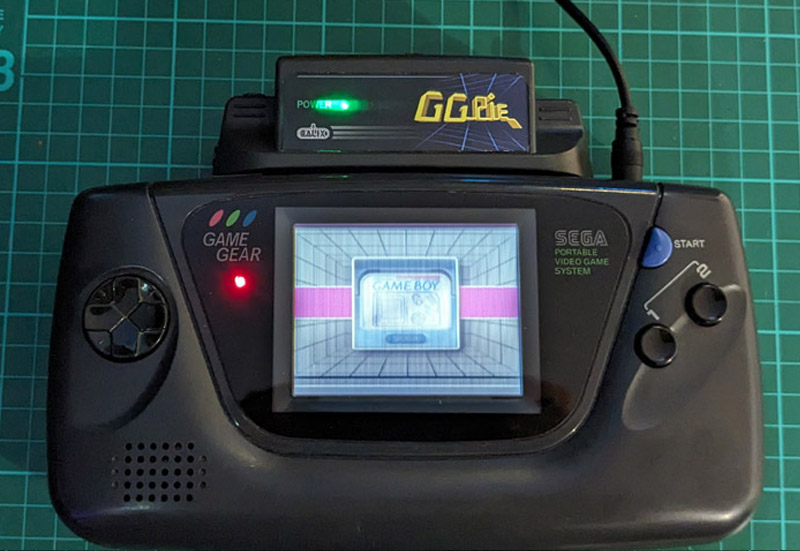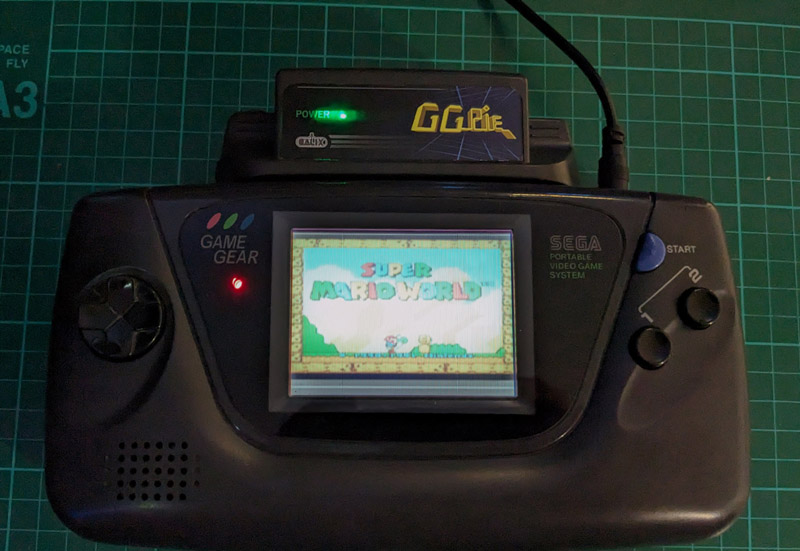Emulate 8/16/32 bits systems on an almost unmodified Game Gear
Imagine having the ultimate accessory for your SEGA Game Gear, nope I’m not talking about unlimited LR6 batteries, but a device you plug into the cartridge port and let you play any game from any 80/90’s console.There is an “easy” way to achieve such a thing, yep, most of you guessed right, the key of this project is to exploit the A/V input of the Game gear Tuner TV. In fact this accessory was designed to display analog TV channels and offers an input jack that allows to display any analog Audio/Video signal from another device, like a tiny and powerful Raspberry Pi zero for example.
So the first thing I did, was to unmount a GG tuner TV to ensure I have enough room to add another PCB and some wires. After gently removing the tuner selector, there was clearly enough room available. I also, and above all, checked if the 5V was stable and solid enough to be shared.
Concerning the embedded emulators, among the several possible options, I choose to install a RetroPie v4.8 on a Pi zero W (µSD Class 10 & 8GB+ recommended). Then I put some roms to test, configured analog audio and video output on the pi zero and finally sent everything to the Tuner TV jack. Result was quite convincing.
So the first thing I did, was to unmount a GG tuner TV to ensure I have enough room to add another PCB and some wires. After gently removing the tuner selector, there was clearly enough room available. I also, and above all, checked if the 5V was stable and solid enough to be shared.
Concerning the embedded emulators, among the several possible options, I choose to install a RetroPie v4.8 on a Pi zero W (µSD Class 10 & 8GB+ recommended). Then I put some roms to test, configured analog audio and video output on the pi zero and finally sent everything to the Tuner TV jack. Result was quite convincing.




Later, I added a custom theme with a simple and clear layout + a VERY big font so I can navigate on roms lists and read games name. I also added a GGPie splash screen, a boot sound and a rom loading screen to customize even more the project.
Adding some more things
The lack of buttons on the Game Gear (2 actions + Start) could be problematic to play some games, so I decided to add a [START] button connected directly on a GPIO.
Thus, I have 3 action buttons like a Megadrive/MegaCd/32X and a [SELECT] button for NES/GameBoy and PC Engine.
Here is the button mapping per console :
Thus, I have 3 action buttons like a Megadrive/MegaCd/32X and a [SELECT] button for NES/GameBoy and PC Engine.
Here is the button mapping per console :
| Btn 1 | Btn 2 | Blue Start | New Button | |
|---|---|---|---|---|
| GB GBcolor | B | A | SELECT | START |
| NES | B | A | SELECT | START |
| MASTER SYSTEM | 1 | 2 | PAUSE | PAUSE |
| PC Engine | 2 | 1 | SELECT | START |
| MD/MCD/32X | A | B | C | START |
| SNES | ? | ? | ? | START |
| Playstation | ? | ? | ? | START |
I also added a small green LED to indicate when module is powered, component is soldered directly to the PI 3.3V GPIO, don’t forget to add a small resistor (100 Ohms in my case)
To prevent noise on audio & video signals, I used some short and thick wires, I also added an analog ground, but I noticed that Pi zero Wifi module was a source of noise even when idle. To fix this, I soldered a 2 states slider switch, connected to the Pi board GPIO and associated with a Python script running in backgound, Wifi can now be disabled when not used.
To prevent noise on audio & video signals, I used some short and thick wires, I also added an analog ground, but I noticed that Pi zero Wifi module was a source of noise even when idle. To fix this, I soldered a 2 states slider switch, connected to the Pi board GPIO and associated with a Python script running in backgound, Wifi can now be disabled when not used.
Did I forgot something ?
I kept the painful part for the end, what about the controls handling, I mean, what happens when I press a Game Gear button ? I can retrieve the buttons state through the cartridge port, that’s how games get this information, right ?
Oh, I even have an official documentation about the pins/bits to read.
What this documentation does not explain is that the Game Gear switch in “TV mode” when it got a Tuner TV module inserted, meaning the whole pins mapping changes and console becomes a simple data receiver. To be more clear, what goes through the cartridge port is only audio & video informations provided by the Tuner TV.
To be perfectly clear:
Oh, I even have an official documentation about the pins/bits to read.
What this documentation does not explain is that the Game Gear switch in “TV mode” when it got a Tuner TV module inserted, meaning the whole pins mapping changes and console becomes a simple data receiver. To be more clear, what goes through the cartridge port is only audio & video informations provided by the Tuner TV.
To be perfectly clear:
There is no way you can get Game Gear buttons state with a Tuner TV plugged.
I discovered this critical issue early in the project, but I decided to continue anyway.
For my tests, I used a standard USB joypad and chose to keep this option in the final ‘product’. But concerning the mandatory feature, playing directly with console’s buttons, it deserved some reflexion and some work. My choice was to expose an USB interface directly into the console’s main board. This means each button was also soldered to an old USB joypad pcb, Game Gear’s original operation kept unchanged but now, we have buttons status through USB.
Now you understand the ‘almost unmodified’.
For my tests, I used a standard USB joypad and chose to keep this option in the final ‘product’. But concerning the mandatory feature, playing directly with console’s buttons, it deserved some reflexion and some work. My choice was to expose an USB interface directly into the console’s main board. This means each button was also soldered to an old USB joypad pcb, Game Gear’s original operation kept unchanged but now, we have buttons status through USB.
Now you understand the ‘almost unmodified’.
To sum up
A classic Game Gear Tuner TV, merged with a small single board computer such as a Pi Zero, can create a unique accessory and allow you to add emulation or why not videos features.
Unfortunately, it seems there’s no way to retrieve console controls without modifying the Game Gear.
And I'll finish with this observation, remember how the whole system works ? Pi Zero emulate games, sends analog audio/video signal to the Tuner TV that converts it to digital informations and sends it to the Game Gear.
The analog part should be removed, the Raspberry video/audio digital data can be directly sent to the Game Gear, but of course, it needs far more work and some custom hardware.
Unfortunately, it seems there’s no way to retrieve console controls without modifying the Game Gear.
And I'll finish with this observation, remember how the whole system works ? Pi Zero emulate games, sends analog audio/video signal to the Tuner TV that converts it to digital informations and sends it to the Game Gear.
The analog part should be removed, the Raspberry video/audio digital data can be directly sent to the Game Gear, but of course, it needs far more work and some custom hardware.
And wait, there’s more!
- Standard power adapter (9V/1A) or 6 reliable batteries (> 1000mAh) is enough to power the whole system.
- Initial Tuner TV A/V input can now be used as video output ! A simple jack/rca cable is required to display games on your TV
- Mod is almost non-destructive, Tuner TV can be restored as original, the only damage is the rear USB cable hole
- For my project I used a simple Pi Zero W, with a Pi zero 2W, boot duration & performances should be twice better
- I didn’t talk about Atari Lynx, Bandai Wonderswan and SNK Neogeo Pocket as I didn’t tested it (because … ‘meh’), but I’m pretty sure games will run flawlessly !
But wait, there’s also ...
- Raspberry Pi output resolution is configured to 320x240, that is quite low but Game Gear resolution is even lower 160x144, so don’t expect to read ingame dialogs
- Sony Playstation emulation is clearly problematic on Pi Zero W, some games crashes, are very slow, have glitches or simply won’t start
- Of course with only 3 action buttons, some Snes and Playstation games (like fighting games) are limited or unplayable
- GGPie can be used on any Game Gear compatible with a Tuner TV that excludes (some?) Majesco and McWill modded consoles
Bonus

